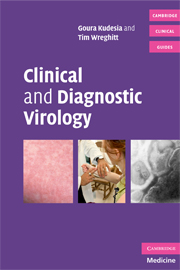Book contents
- Frontmatter
- Contents
- List of plates
- Preface
- Acknowledgements
- SECTION 1 INDIVIDUAL VIRUSES
- SECTION 2 OTHER RELATED AGENTS
- SECTION 3 CLINICAL SYNDROMES
- 32 Central nervous system viral infections
- 33 Viral eye infections
- 34 The common cold
- 35 Respiratory virus infections
- 36 Atypical pneumonia
- 37 Gastroenteritis viruses
- 38 Viral hepatitis
- Chapter 39 Genital tract and sexually transmitted infections (STIs)
- 40 Glandular fever-type illness
- 41 Viral rashes and skin infections
- 42 Infections in pregnancy, congenital and neonatal infections
- 43 Virus infections in immunocompromised patients
- 44 Viral malignancies
- 45 Travel-related infections
- SECTION 4 DIAGNOSTIC TECHNIQUES
- SECTION 5 PATIENT MANAGEMENT
- Index
- Plate section
Chapter 39 - Genital tract and sexually transmitted infections (STIs)
Published online by Cambridge University Press: 07 December 2009
- Frontmatter
- Contents
- List of plates
- Preface
- Acknowledgements
- SECTION 1 INDIVIDUAL VIRUSES
- SECTION 2 OTHER RELATED AGENTS
- SECTION 3 CLINICAL SYNDROMES
- 32 Central nervous system viral infections
- 33 Viral eye infections
- 34 The common cold
- 35 Respiratory virus infections
- 36 Atypical pneumonia
- 37 Gastroenteritis viruses
- 38 Viral hepatitis
- Chapter 39 Genital tract and sexually transmitted infections (STIs)
- 40 Glandular fever-type illness
- 41 Viral rashes and skin infections
- 42 Infections in pregnancy, congenital and neonatal infections
- 43 Virus infections in immunocompromised patients
- 44 Viral malignancies
- 45 Travel-related infections
- SECTION 4 DIAGNOSTIC TECHNIQUES
- SECTION 5 PATIENT MANAGEMENT
- Index
- Plate section
Summary
True sexually transmitted infections are those that are transmitted only through sexual activity, but there are many in which sexual transmission is one of the routes and others that even though not strictly transmitted via the sexual route may be transmitted through related sexual practices. It is important to remember that many of these patients may not perceive themselves at risk of a sexually transmitted infection, and therefore may present outside the genito-urinary medicine setting.
Clinical
Sexually transmitted viral infections can be divided into two groups:
those that present with localized genital lesions or symptoms
those that are systemic infections but may also be transmitted via sexual route or during related sexual activity.
This chapter will consider only those pathogens that cause local genital lesions; refer to the appropriate chapters in the book for those that have a systemic manifestation.
Vesicular or ulcerative genital lesions
Herpes simplex virus is the commonest cause, but occasionally varicella-zoster virus may also cause localized genital lesions, which may be clinically difficult to distinguish from herpes. Clinical examination may reveal a shingles-like distribution along a sensory nerve in a case of varicella-zoster virus infection. The distinction is important to make as a higher dose of aciclovir is required to treat varicella-zoster.
Acute syphilis may present as an ulcerative gummatous lesion.
- Type
- Chapter
- Information
- Clinical and Diagnostic Virology , pp. 160 - 163Publisher: Cambridge University PressPrint publication year: 2009



